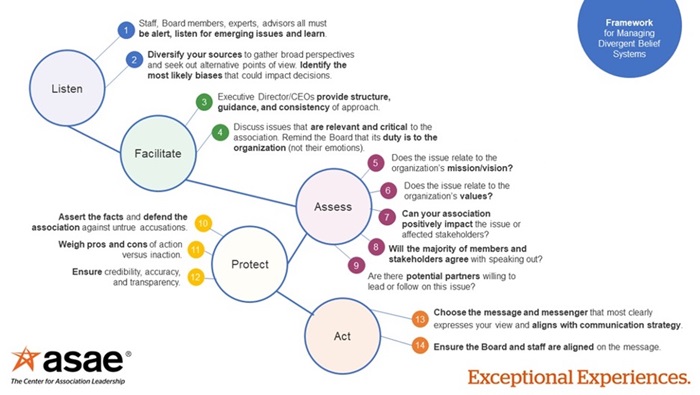Kristi Donovan, CAE
Kristi Donovan is a practice director on the strategy and innovation team at McKinley Advisors. She joined McKinley with more than 20 years of experience working in professional and trade associations.

Association executives face the daunting task of managing divergent beliefs among stakeholders when it comes to today’s challenging global issues. We provide a framework for leaders to skillfully balance listening, facilitating, and protecting their organizations while fostering unity in a polarized landscape.
Economic uncertainty, inequality, climate change and civil unrest. These are just a sample of the long-term trends on the horizon facing associations, and they are often accompanied by divergent, or opposing, beliefs held by members, stakeholders, and association staff.
Divergent belief systems represent fundamental differences in how individuals view, understand, and perceive important issues. These differences in beliefs go beyond simple and constructive differences of opinion in that they are highly emotionally charged, tend to be inflexible (i.e., individuals are unlikely to change their position), and are oftentimes connected to a political or social identity. They may also be rooted in different interpretations of fact.
Association CEOs, boards, and staff members want to do the “right thing” when it comes to addressing these big problems, but knowing exactly what that is is becoming more challenging.
Association executives are responsible for leading both their organizational and people strategies. Association CEOs must be strong listeners, facilitators, and protectors of their organizations. However, listening, facilitating, and protecting requires a more thoughtful, intentional, and nuanced approach when dealing with divergent belief systems.
Following research conducted across ASAE’s CEO community, participants in the ASAE Association Insights Center (AIC) recently contemplated and analyzed their individual and collective experiences as CEOs in relation to divergent beliefs. The research and their synthesis surfaced the fundamental roles of CEOs when dealing with divergent belief systems: listen, facilitate, assess, protect, and act.
These challenging times will continue and become increasingly frequent, and association leaders must find confidence in their ability to not only lead but use these points of tension as an opportunity to build stronger communities. The model for association leaders isn't necessarily to react or solve the issue but rather to provide space for their stakeholders to voice and unpack their point of view while building strength as a united field. CEOs can play that role by following the framework below.

Listen. Take care to listen deeply and ensure stakeholders feel heard.
Facilitate. Use a consistent, transparent, orderly, and defensible process to hear all sides on relevant issues.
Assess the rationale. Be the voice that reflects and reframes the issues back to the mission, vision, values, and strategy of the organization.
Protect the organization. Navigate the necessity of the conversation, determine the need to take action or not, and provide the information needed for the board to take action—always with the organization’s best interests, mission, and strategy in mind.
Act. Steer through uncertainty with clear intention and communication.
Understanding the intricacies of each part of the framework can help guide and navigate your responses to the complexities of divergent belief systems. Find the full resource for managing divergent beliefs at www.asaecenter.org/aic.
Interested in becoming a part of this just-in-time research designed to address the toughest issues you are facing right now? ASAE’s Association Insights Center is a community of experts collaborating to face the increasingly complex environment and challenges ahead. In partnership with McKinley Advisors, the AIC provides critical, on-demand intelligence and tools to support association CEOs as they face the difficult decisions yet to come. Join us as we embark on our third year of research.